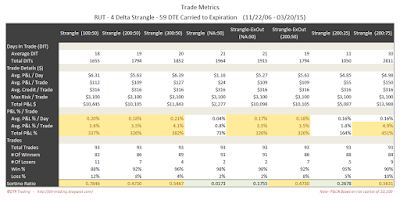For background on the setup for the backtests, as well as the nomenclature used in the charts and tables below, please see the introductory article for this series: Option Strangle Series - Higher Loss Thresholds
In the trade metrics tables, I have highlighted the rows to indicate values that are in the upper half of the readings. One of the metrics to note is the average P&L per day in percentage terms (Trade Details (%) - Avg. P&L / Day). This is a measure of the P&L per day normalized to the maximum initial portfolio margin (initial PM) required for that trade run...it tells us the effectiveness of theta with respect to our margin requirement.
Also note, that all of the blog posts for the RUT strangle series have equity curves with identical y-axis scales, unless otherwise noted.
4 Delta Short Strikes
 |
| (click to enlarge) |
 |
| (click to enlarge) |
6 Delta Short Strikes
 |
| (click to enlarge) |
 |
| (click to enlarge) |
8 Delta Short Strikes
 |
| (click to enlarge) |
 |
| (click to enlarge) |
With the 59 DTE tests, the highest average P&L per day readings occurred with the 8 delta short strike variations, with an average of 0.19% per day. The highest overall P&L per day reading occurred with the 8 delta 300:50 and ExOut 200:50 variations, at 0.22% per day. In the next post we will look at these same deltas and exits, but on the RUT 66 DTE short strangle.
Follow my blog by email, RSS feed or Twitter. All options are free, and are available on the top of the right hand navigation column under the headings "Subscribe To RSS Feed", "Follow By Email", and "Twitter". I follow blogs by RSS using Feedly, but any RSS reader will work.
2 comments:
Hey Mark,
You’re typically detailed and thorough in explaining your testing parameters so please accept my apologies for missing it elsewhere, but when you use the term “… with a maximum risk of…” what should we assume the margin model to be if it is not explicitly stated in a post: Reg T or portfolio margin?
This post clearly states portfolio margin is used in the tests, but on some earlier posts, I’m not sure which risk method is used.
Again, thank you for sharing your astute back testing knowledge and suite of tools.
Best,
Michael
Michael,
For defined risk trades (iron condors, iron butterflies, etc), I used the normalized max risk for a trade run. For example, for a test run including 99 trades, the risk for a 20 point wide iron condor would vary across all 99 those trades based on the different credits received. The largest risk out of all of the 99 trades is the value that I would use for the max risk for the run.
For the undefined risk trades (strangles, straddles, etc.), I used the initial PM requirement for the trade run. This is obviously not "max risk", since these trades have undefined risk.
Thanks,
Dave
Post a Comment